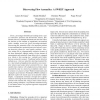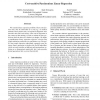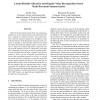ICDM
2008
IEEE
15 years 7 months ago
2008
IEEE
Given a percentage-threshold and readings from a pair of consecutive upstream and downstream sensors, flow anomaly discovery identifies dominant time intervals where the fractio...
137
Voted
ICDM
2008
IEEE
15 years 7 months ago
2008
IEEE
This paper studies evolutionary clustering, which is a recently hot topic with many important applications, noticeably in social network analysis. In this paper, based on the rece...
140
click to vote
ICDM
2008
IEEE
15 years 7 months ago
2008
IEEE
OLAP (On-Line Analytical Processing) is an important notion in data analysis. Recently, more and more graph or networked data sources come into being. There exists a similar need ...
112
Voted
ICDM
2008
IEEE
15 years 7 months ago
2008
IEEE
We present a new visualization of the distance and cluster structure of high dimensional data. It is particularly well suited for analysis tasks of users unfamiliar with complex d...
83
Voted
ICDM
2008
IEEE
15 years 7 months ago
2008
IEEE
We examine linear regression problems where some features may only be observable at a cost (e.g., in medical domains where features may correspond to diagnostic tests that take ti...
107
Voted
ICDM
2008
IEEE
15 years 7 months ago
2008
IEEE
Multi-Document Summarization deals with computing a summary for a set of related articles such that they give the user a general view about the events. One of the objectives is th...
79
Voted
ICDM
2008
IEEE
15 years 7 months ago
2008
IEEE
We present a classification algorithm built on our adaptation of the Generalized Lotka-Volterra model, well-known in mathematical ecology. The training algorithm itself consists ...
105
Voted
ICDM
2008
IEEE
15 years 7 months ago
2008
IEEE
Many data sets are incomplete. For correct analysis of such data, one can either use algorithms that are designed to handle missing data or use imputation. Imputation has the bene...
87
Voted
ICDM
2008
IEEE
15 years 7 months ago
2008
IEEE
In this paper, we present a novel feature extraction framework, called learning by propagability. The whole learning process is driven by the philosophy that the data labels and o...
88
Voted
ICDM
2008
IEEE
15 years 7 months ago
2008
IEEE
1 The aim of data mining is to find novel and actionable insights. However, most algorithms typically just find a single explanation of the data even though alternatives could e...



